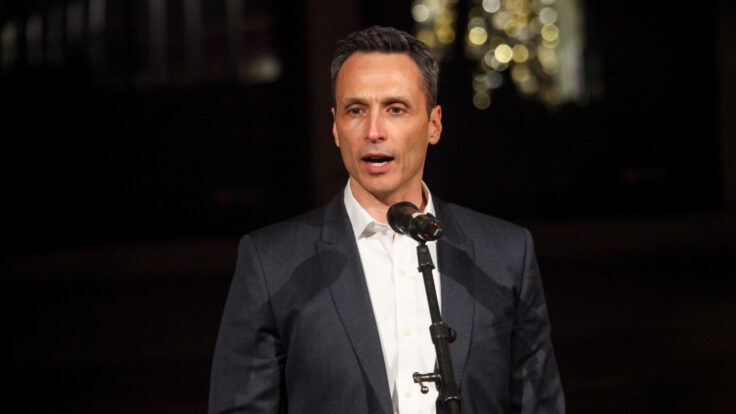|
Good morning,
Thanks for reading The Backstory, our weekly catalog of the best new work at Puck.
It was another fantastic week: Lauren Sherman investigated a multi-billion-dollar succession plot; Matt Belloni reflected on the town’s agency crises and presaged the post-strike Hollywood landscape; Eriq Gardner compiled the definitive “who is suing who” list and chatted with Teddy about S.B.F.; Dylan Byers explained a Washington Post surprise; Julia Alexander dug into Apple TV+’s price hike economics; and Julia Ioffe revealed an Israel-Hamas war crimes complexifier.
Check out these stories, and others, via the links below. And stick around for the backstory on how it all came together.
|
FASHION:
Lauren Sherman crowns fashion’s new “it” girl and breaks down the politics in the House of Lauder.
WALL STREET:
Bill Cohan inspects the $136 billion dynamite stick on BofA’s balance sheet.
MEDIA:
Dylan Byers breaks news on the WaPo C.E.O. search and offers an advanced study of Condéology.
HOLLYWOOD:
Matt Belloni delves into CAA and WME’s various headaches and also lays out the town’s post-strike economic landscape.
and…
Julia Alexander deciphers Apple’s real streaming strategy.
SILICON VALLEY:
Teddy Schleifer and Eriq Gardner swap S.B.F. theories.
WASHINGTON:
Baratunde Thurston reveals how you can grieve two peoples at once while Julia Ioffe asks the tough questions about war crimes.
and…
Peter Hamby talks to Dean Phillips about his prairie home rebellion.
Meanwhile…
Tara Palmeri captures third party fever; Tina Nguyen examines Mike Johnson’s street cred; and Abby Livingston offers the true inside dish from inside the circus tent.
PODCASTS:
🚨 If you haven’t already, please listen to the entirety of Julia Ioffe’s predictably brilliant podcast, About a Boy: The Story of Vladimir Putin.
and…
Matt Belloni chats with Bethenny Frankel about collective bargaining for reality stars on The Town.
and…
Tara Palmeri discussed the short-lived Pence candidacy with the former V.P.’s political mastermind, Marc Short, on Somebody’s Gotta Win.
and…
Peter Hamby and I philosophized about Ari Emanuel’s take-private ambitions on The Powers That Be. |
| Editing, one of those jobs that’s almost impossible to adequately explain with cocktail party brevity, really all comes down to a single word: learning. And one of my favorite parts of life at Puck, after all, isn’t simply absorbing the reporting and analysis from my generationally-talented colleagues, but also interpreting how developments from their various domains of expertise contextualize the tectonic changes taking place in adjacent industries.
As I’ve noted a few times in this intimate space, I came of age professionally at the end of the magazine era—that near century of money-minting innovation that stemmed from the moment Henry Luce and Briton Hadden founded Time, in 1923, to the post-9/11 recession and, eventually, the financial crisis of 2008-09, the industry’s true Big Bang. The experience of watching larger-than-life cultural institutions slowly erode before my eyes was a haunting lesson that has long stuck with me. And it’s helped me elucidate the larger rebundling taking place across our culture in innumerable ways.
In the entertainment media space, to wit, everyone expects a handful of legacy incumbents to shrink to a few players over the coming years. This week, the peerless Matt Belloni presaged the town’s new economic terrain in his remarkably lucid and chillingly Lindelof-ian piece, Hollywood’s Post-Strike Hellscape. On Wall Street, a new cohort of smaller investment firms are remaking the landscape. And even the most hegemonic players can’t rest on their history. This is the context for Bill Cohan’s excellent new story, BofA’s $136 Billion Dynamite Stick.
This dynamic is obviously at work in politics, too. As Tara Palmeri notes this week in her excellent report, ’24 Enters the Third-Party Voyeurism Phase, even the two-party system is increasingly being stress-tested. Meanwhile, some transformations are swifter than others—a remarkable fact that underpins Eriq Gardner and Teddy Schleifer’s discourse on the charlatan Sam Bankman-Fried in Sam I Am, a must-read in my view.
And yet I find myself, again and again, seeing the cues for the future of our culture emanating from the fashion industry, the most historic of the businesses that we cover here at Puck. LVMH, the luxury conglomerate and Europe’s second largest company (behind the drug maker that manufactures Ozempic… you can’t make this stuff up), derives its name from brands founded a century ago. LVMH’s ability to take historic, important assets and not only nourish them but scale them, is a consequential lesson for executives in Hollywood and dealmakers in New York and San Francisco.
It doesn’t always work perfectly, however. If you only have time to read one piece this weekend, I’d strongly urge that you sit down with Lauren Sherman’s brilliant piece on the Lauder family, the dynasty behind Estée Lauder Companies, titled American Beauty. In the story, Lauren elegantly explains how scion Leonard Lauder scaled his mother’s enterprise into a global behemoth, often mirroring the paradigm set by the large European fashion conglomerates. It worked excellently until, well, it didn’t. The lessons endured are relevant across our various power corridors. After all, this is precisely the sort of story that you can only find at Puck.
Have a great weekend,
Jon |



















